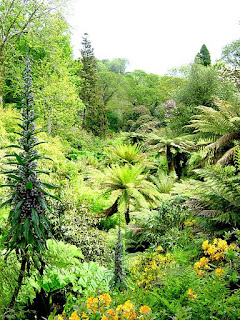Mount Grace
Priory was one of ten Carthusian monasteries, or “Charterhouses” that were
founded in England
prior to the dissolution of the monasteries, which took place during the reign
of King Henry VIII. Its ruins are the best-preserved of the ten, and are well
worth a visit if you are in the area.
The
Carthusians originated in 1084 as a reaction to what was regarded by some as
corruption in the Church at that time. Bruno of Rheims sought a means of
withdrawing from the world to a life of prayer and meditation, and founded a
small community at Chartreuse, a remote mountainous location in eastern France. Life
there was particularly austere, and the monks became known as “Christ’s Poor
Men”.
In time, the
Carthusian ideal spread throughout France
and then into England,
with the Mount Grace Priory being founded in 1398. It closed in 1539. It is
sited on the western edge of the North York Moors, with a steep wooded hillside
rising up on one side. It is very accessible to visitors, being close to
several main roads and rail lines that sweep from south to north through the
Vale of York, but at the time of its building this would have been a very
remote location. Modern visitors are still struck by the tranquillity of the site.
The most
striking difference between a Carthusian monastery and those of other monastic
orders, such as the Cistercians at nearby Rievaulx, is that the monks did not
live communally but as hermits, only meeting for worship in the church three
times a day. On Sundays, a communal meal would be eaten in silence, followed by
a meeting in the Chapter House. The rest of a monk’s time was spent in his
private cell, where he prayed, worked, ate and slept on his own.
There was
only room for seventeen monks, plus the prior, and six lay brothers who worked
in the kitchens, maintained the priory grounds and performed other domestic
duties. This meant that there was no call at Mount Grace
for a large church, dormitory or refectory, which are typical features of other
monasteries.
The
considerable overall size of the site, and particularly of the Great Cloister,
is because each monk had his own self-contained cell, a two-storey building
with a small garden plot attached. Although these cells were not large, either
in dimensions or number, they still needed to fit around a quadrangle, which is
what we can see today as the Great Cloister, a larger area than is common in
monasteries of other orders that accommodated many more monks than at Mount Grace.
Although the
site is largely in ruins, one of the cells has been reconstructed and furnished
to show visitors exactly how a Carthusian monk would have worked. This
reconstruction was originally done in 1901-05, so the stonework and roof tiles
have mellowed over time to give today’s visitors a real sense of how it would
have been in the early 16th century, as has the more recent
refurbishment with items that a monk would have had at his disposal.
Next to the
cell door is an open hatch, into which a lay brother would place a tray
containing the monk’s simple meal, twice a day. The arrangement meant that the
monk and lay brother did not have to communicate in any way at these times.
The ground
floor was divided into small rooms by wooden partitions, so that the monk had a
living-room with a fireplace, a study, a bedroom and an oratory (a private
prayer room). He also had a private cloister, a small covered passageway in
which he could walk up and down for exercise and which also gave access to the
garden. In the corner of the garden was the latrine, flushed by spring-water
channelled from the nearby hillside.
The upper
floor was the monk’s workroom. Every monk had to practice a trade, the produce
of which was shared by the other monks or went towards the upkeep of the
monastery. The upper floor of the restored cell was equipped with a spinning
wheel and loom when I visited some years ago, but we can imagine that some
monks would have been engaged in trades such as woodcarving, pot-making or
illuminating manuscripts. The upper rooms would have had the advantage of good
natural light for delicate work.
As well as
working at their trade, the monks had to tend their gardens, perhaps growing
medicinal herbs or vegetables for the kitchens (Carthusians did not eat meat).
They also had a fixed timetable of religious offices, for although they did not
meet together for all the prescribed services, they celebrated the others in
private.
Visitors can
also see the ruins of the priory church, with its bell tower, and the outlines
of the walls that mark the locations of several other buildings, such as the
granary, kiln and stables.
The original
monastery guesthouse was incorporated in the 17th century into a
manor house built by the then owner of the site, Thomas Lascelles, and this was
further extended in 1900-01 by Sir Lowthian Bell, and furnished in the style of
the Arts and Crafts movement. Not all of the manor house is open to visitors,
but the exhibition that tells the full story of Mount Grace
is located on the upper floor.
The property
is now owned by the National Trust but managed and maintained by English
Heritage.
English
Heritage recommends allowing an hour and a half for a visit, but you may wish
to stay longer to drink in the atmosphere and listen to the birdsong, if the
weather is fine. You could combine a visit with one to Rievaulx, reachable via narrow
roads across the moors, and compare and contrast the monastic life of the two
communities.
© John
Welford




